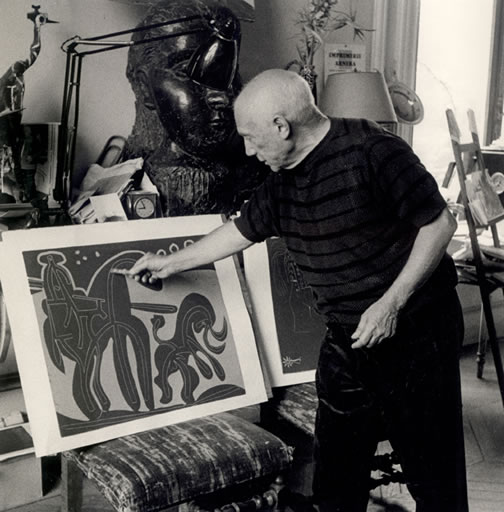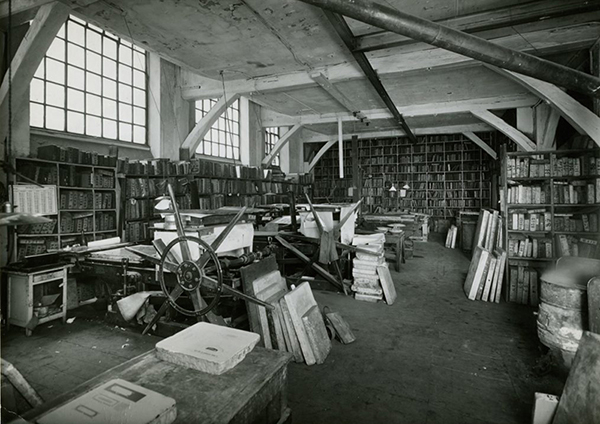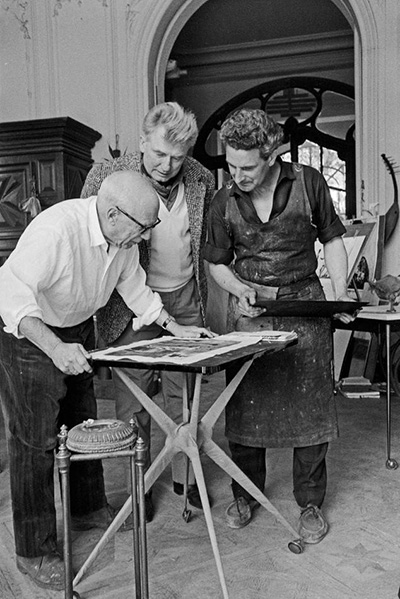 |
PRINTS BY
PABLO PICASSO
THE TIMOTHY COLLINS COLLECTION
Curator:
Eric Mourlot
Mourlot Editions
Organized by
LANDAU
TRAVELING EXHIBITIONS
|
|
 |
|
|
 |
A GRAPHIC JOURNEY
PRINTS BY
PABLO PICASSO
|

Picasso examining a linocut
|
|
|
|
A new exhibition featuring prints by Pablo Picasso is being made available for circulation through 2027. Presented are 57 works created between 1923 and 1972 - etchings, lithographs and linocuts, plus one cancelled copper printing plate. An introductory essay by Exhibition Curator, Eric Mourlot, grandson of Fernand Mourlot, one of Picasso’s most important printers, accompanies the exhibition. The works come from the collection of Timothy Collins of Los Angeles, CA.
Picasso was a major innovator in the medium of printmaking. He made prints throughout his career — his first in 1899, when he was still a teenager; his last in 1972, when he was 90. Experimenting all the while, he produced some 2,400 prints in total, in a wide variety of techniques, most notably etching, lithograph and linocut. Over the decades he worked with numerous print ateliers, including Arnera, Mourlot, Crommelynck, Frelaut, Lacouriere, Desjobert, and Fort.
A special feature of the Collins Collection is the number of proofs. These proofs illustrate the unique working relationship Picasso maintained with his printers and their ateliers and allows for the examination of the working process behind it. Their craftsmanship made Picasso's extensive and revolutionary experimentation with the media possible. In the six examples of Tete de Femme au Chapeau, (above) from the exhibition, we can see preliminary proofs in the various colors along with the final full color print.
Another highlight of the exhibition is a cancelled original copper printing plate from 1948, Femme au Chignon, along with a print pulled from the plate.
The exhibition was organized by Landau Traveling Exhibitions, Los Angeles, CA. Exhibition dates are available beginning in September, 2022 - 2025.
|
|
 |
|
|
 |
A GRAPHIC JOURNEY
PRINTS BY
PABLO PICASSO

The Mourlot Atelier, Paris
By Eric Mourlot
Mourlot Editions, 2021
A GRAPHIC JOURNEY: PRINTS BY PABLO PICASSO - The Timothy Collins Collection - The Timothy Collins Collection presents an important and insightful gathering of etchings, lithographs and linocuts by one of the great masters of the 20th Century. This exhibition provides a unique window into a significant era in art history, and takes a serious and scholarly look at Picasso’s development and creative process, often not as accessible in his paintings.
The exhibition richly illustrates the three major phases of Picasso’s printmaking career, as well as all his major artistic themes. One of Picasso’s strengths was his ability to tackle every major topic of humanity including love, death, war, power and envy. The “bull”, for example, is one of Picasso’s favored and most powerful images in his work – at times symbolizing the people of Spain, the brutality of war, or most commonly perhaps, male virility, especially his own. Picasso is omnipresent in his works, sometimes as a bull, sometimes as a man and at times, several characters simultaneously. This is perfectly represented in Quatre Femmes Nues et Tête Sculpture, 1934 (#7), where, he does not directly portrays himself as a character, but rather as a sculpture, that gazes ominously upon the women that he has conquered.
|
Quatre Femmes Nues et Tête Sculpture, 1934
|
|
|
|
Picasso's graphic journey begins in earnest early after his move to Paris, at the beginning of the 20th century. His approach to print making was interesting in itself; He would work intensively in a given technique for a period of time, while developing a close relationship with the printers. In each studio, he would explore and innovate until fully satisfied, before he would finally move on to a new project.
|
Etching – Georges Lacourière. (1920’s and 1930’s)
The first of these compelling relationships was with the intaglio process and the master printer Georges Lacourière. In some of the first etchings in the collection, the artist is deftly but simply transposing some of his more dominant themes at the time into graphics. This decidedly classical style work came about around the end of World War I and was characterized by its weighty and serene figures, donning tactile robes in simple landscapes. It was heavily influenced by classical Greek and Roman art as in Deux femmes regardant un model nu from 1923 (#1). A still canonical influence, probably closer to the Renaissance period, is apparent in La lecture from 1926 (#2) ,where he uses technics such as “Clair-Obscur” (half-light) in a way reminiscent of Rembrandt’s work.
|
Deux femmes regardant un model nu, 1923
|
|
|
|
Minotaur, Buveur et Femmes, 1933
|
|
|
|
As Picasso becomes more proficient, his imagery becomes more abstract and rifer with experiments. With the help and influence of master printer Georges Lacourière, he explores and masters all the technical intricacies of the intaglio process. This allows him to push the boundaries and truly dominate the medium, as it is apparent in Minotaur, Buveur et Femmes from 1933 (#4).
However, the highlight of the Collins Collection, when it comes to etchings, has to be the original plate from the Gongora suite. The presence of an extremely rare copper matrix with its matching offspring, Femme au Chignon from 1948 (#15, #16), allows us to really understand and visualize part of the printing process. The artist creates a simple but incredibly graceful portrait, arguably inspired by Matisse’s own work at the time, with the confidence and talent that is only afforded to those that have spent years perfecting their craft. There are no hesitations and the lines are determined and pure. To the untrained eye, it may seem too simple, but it is an incredibly difficult feat to achieve.
|
Femme au Chignon, 1948
The rare copper plate filled with thick etching ink in its grooves was transferred onto paper to create the most delicate and elegant rendering of a woman’s beauty, easily recognized as Francoise Gilot, his lover during these years, by the obviously angular eyebrows and defiant stare.
As the viewer will notice, the plate was then “scratched” with two hard strokes to prevent any more recognizable printing of that image when the final edition was finished.
Lithography – Fernand Mourlot (1940’s and 1950’s)
While Picasso had temporarily been interested in lithography in the nineteen twenties, he had abandoned it when he didn’t seem to find a printer whose temperament suited his. It is not until the mid-nineteen forties, that upon the recommendations of Henri Matisse and Georges Braque, he will meet and start working in the Paris studio of master printer Fernand Mourlot. There, he finally found a lithographer that could respond to his demands and his impulses. Mourlot understood the artist’s need for freedom and flexibility. He will therefore unlock the usually rigid and patriarchal old ways of doing business and let the artist work outside the studio, sometimes sending stones and plates late in the evening for him to work in his kitchen throughout the night.
|
Head of a Young Girl, 1945
|
|
|
|
Most of the works in the collection are worthy of being explored for their craftsmanship as much as for their artistic value. During his prolific stay at the Mourlot Studio, and while working on Head of a Young Girl, 1945 (#10), Picasso, was still at the beginning of his relationship with the young painter Francoise Gilot. She became the subject for many of his early lithographs and the viewer can see her as one of his main inspiration. Yet, it is also a phase of broad exploration of the lithographic medium. The artist investigates and probes all the new possibilities that differ from the etching process and are closer in style to drawing and painting. As Fernand Mourlot would later write of Picasso “He looked, he listened, he did the opposite of what he had learnt – and it worked.”
|
Head of a Young Girl, 1963
|
|
|
|
Lithography allowed Picasso to work with speed and experiment freely, and so, in this collection we can see works of art that evolve as the artist is able to alter the matrix more easily, at times reworking the stone with crayons, or scraping it with different metallic instrument he found in his kitchen. He often used materials that had never been employed in that medium, such as wax or gasoline. The results could initially be spectacular, but too unstable to allow for the production of a full edition. Hence the rarity and importance of the some of the proofs such as Head of a Young Girl, 1963 (#24), M.147 and La Femme au Miroir, 1950 (#25) M.197, that illustrate the artist’s constant need to push the barriers of what had been accomplished before.
|
Picasso’s mood seems to lighten also during this period, perhaps because of his relationship, but also because the dark days of the Second World War had finally come to an end. Gilot herself writes in her 1964 New York Times Bestseller Life with Picasso, that the Master deeply enjoyed working with a large group of “blue collar” craftsmen who treated him like one of their own.
 |
Unfortunately, soon after the birth of two children with Francoise, the relationship would come to an end and Picasso would again move on, only to usher in the third foray into a new medium: linocuts. He did not entirely abandon lithography though and would often call on Fernand Mourlot, my grandfather, whenever he visited the capital. Picasso would also often request zinc plates to be shipped to his new homes in Cannes and later Mougins. There he would work at his own pace until he would summon my grandfather to visit him and pick up the plates – so much so that our family purchased a villa in Mougins, as staying for weeks in the Hotels of the Riviera became prohibitive. This relationship would last another decade until his death in 1973 and to this day, our families remain close.
|
|
Linocuts – Hidalgo Arnera (1958 – 1960’s)
With his last relationship over as a result of his many affairs, Picasso moved from Paris to the South of France with his new lover, Jacqueline Roque. Without the advantages of Mourlot’s large studio and staff, Picasso turns to a different medium – one with which he had become familiar while attending many Bullfights: linocuts. In those days, the posters advertising the Corridas were mainly printed with what was a simple and inexpensive but efficient method.
Initially, the linocut process proved arduous and impractical. It required a separate linoleum block to be carved for each color that the artist wished to add, but that could also easily result in misaligned prints. However, Picasso’s genius and ability to quickly adapt, allowed him, with the help of printer Hidalgo Arnera, to develop their own method for multi-colored prints using just one linoleum block. The speed of the process of linocuts suited Picasso and working closely with Arnera, he created over one hundred different editions in the following years.
|
La Dormeuse, 1962
In the Collins Collection, this achievement is reflected in two extremely rare sets: Tête de femme au Chapeau, 1962 (#39, #40, #41,#42,#43, #44) (pictured at the top) and La Dormeuse , 1962 (#44,#45,#46). It is impossible not to marvel at the accomplishment of those series, let alone the insight that the viewer gets from witnessing the progression. This is veritably the heart of this exhibition and the pinnacle of Pablo Picasso’s printing exploits. It is only through that ultimate confidence that an artist achieves when he has completely mastered his craft, that he is able to “create” such beauty, through the “destruction” of one single matrix. There, we see that the artist has no recourse if he makes a mistake; once the linoleum block has been carved, there is no way back to fix it as it still could be in lithography.
# # #
Over his lifetime, Picasso completed over 2400 different graphic works, in addition to his paintings, sculptures and ceramics. Thousands of these prints are not only located in major institutions such as Museums, Universities and Libraries around the world, but also in great private collections. Hundreds of books have been written just on his graphic output, where it has been thoroughly studied, referenced and analyzed. Several of his prints have broken records at auctions, where they have sold for amounts greater than some of his unique works, including paintings. Therefore, it is safe to say that, no one since Rembrandt has been more significant, prolific and proficient than Picasso in the entire history of artistic printing. This exhibition is another proof of this fact.
___________________________________________________________________
Eric Mourlot
Eric Mourlot was born in 1970 in New York City while his father Jacques was running the studio on Bank Street and after two years, the family relocated back to Paris for Jacques to take over the main studio. It was here where he, as a child, began to spend his evenings learning various printing techniques with the help of artists including Marc Chagall, Alexander Calder, and Joan Miró. Eric participated in the printing process, cleaning off the machine rollers and developing a keen sense for his surroundings as a source of inspiration and creativity. He quickly became passionate about the relationships and collaborations between artists, printers, gallerists, and publishers leading him to open his first gallery on Newbury Street in Boston in 1991. In 2005, Galerie Mourlot relocated to its current Upper East Side location in NYC where Eric continues to provide a platform for artists to create history. Mourlot Editions is the legacy of his family’s print shop, the next chapter of the story. An avenue of expression where Eric can display both the works and histories of the artists his father and grandfather created with, as well as expose the continued relationship between printers and artists through the process and art form of lithography.
|
|
 |
|
|
A GRAPHIC JOURNEY
PRINTS BY
PABLO PICASSO
Exhibition Details
Contents: 57 framed works including one copper printing plate,
cd with text panels and labels, plus photomurals
- List of Works & Images -
Lecturer: Exhibition Curator, Eric Mourlot
Space Req: 250-300 running feet
Dates Avail: September 2026 - 2025
Loan Fee: Upon request
Insurance: Exhibitor responsible
Shipping: Exhibitor responsible
Req: Appropriate security, environmental controls
Contact: LANDAU TRAVELING EXHIBITIONS
Email: info@a-r-t.com Tel: 310 397 3098
|
____________________________________
Exhibition Schedule
as of 10/02/25
2022
September 1 - December 4
Brenau University Gallery
Gainesville, GA
2023
July 9 - September 18
Huntsville Museum of Art
Huntsville, AL
November 11 - March 3, 2024
Washington County Museum of Fine Arts
Hagerstown, MD
2024
March 15 - June 15
Alexandria Museum of Art
Alexandria, LA
2025
February 1 - May 5, 2025
Longmont Museum
Longmont, TX
2026
January 1 - September 7
OPEN
September 25 - December 6
Coral Springs Art Museum
2027
OPEN
___________________________________
CONTACT
For More Information & To Schedule Dates Please Contact
LANDAU
TRAVELING EXHIBITIONS
www.a-r-t.com
Tel 310 397 3098 Email info@a-r-t.com
|
|
|